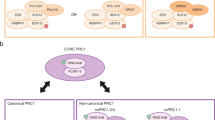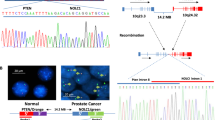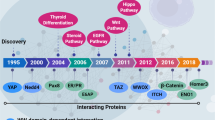Abstract
The PTCH1 gene is a human tumour suppressor gene frequently mutated in basal cell carcinoma (BCC) and several other tumour types. It encodes a receptor for soluble factors of the hedgehog family. Binding of hedgehog to the receptor relieves its inhibitory action on the transmembrane co-receptor Smoh. In this study we describe alternative first exons of the PTCH1 tumour suppressor gene and show that they are differentially regulated in normal tissues, exon 1B being expressed at very low levels and the major mRNA species containing exon 1 or 1A. Exon 1B transcripts were found to be specifically upregulated in nodular BCCs. The different PTCH1 transcripts all encode proteins that interact with Smoh in doubly transfected cells. Furthermore, functional assays demonstrated that whereas all PTCH1 isoforms can inhibit the activity of SHH, only the PTCH1B isoform is capable of fully inhibiting Smoh activity. The results indicate that in tumour cells the PTCH1B promoter is specifically activated and importantly, that the N-terminal part of PTCH1 including exon 1B is required for full inhibition of Smoh signaling but not for physical interaction with Smoh.
This is a preview of subscription content, access via your institution
Access options
Subscribe to this journal
Receive 50 print issues and online access
$259.00 per year
only $5.18 per issue
Buy this article
- Purchase on Springer Link
- Instant access to full article PDF
Prices may be subject to local taxes which are calculated during checkout









Similar content being viewed by others
References
Gailani MR, Ståhle-Backdahl M, Leffell DJ, Glynn M, Zaphiropoulos PG, Pressman C, Unden AB, Dean M, Brash DE, Bale AE, Toftgard R . 1996 Nat. Genet. 14: 78–81
Hahn H, Christiansen J, Wicking C, Zaphiropoulos PG, Chidambaram A, Gerrard B, Vorechovsky I, Bale AE, Toftgård R, Dean M, Wainwright B . 1996a J. Biol. Chem. 271: 12125–12128
Hahn H, Wicking C, Zaphiropoulos PG, Gailani MR, Shanley S, Chidambaram A, Vorechovsky I, Holmberg E, Unden AB, Gillies S, Negus K, Smyth I, Pressman C, Leffell DJ, Gerrard B, Goldstein AM, Dean M, Toftgård R, Chenevix-Trench G, Wainwright B, Bale AE . 1996b Cell 85: 841–851
Incardona JP, Lee JH, Robertson CP, Enga K, Kapur RP, Roelink H . 2000 Proc. Natl. Acad. Sci. USA 97: 12044–12049
Ingham PW . 1998 EMBO J. 17: 3505–3511
Ingham PW, Nystedt S, Nakano Y, Brown W, Stark D, van den Heuvel M, Taylor AM . 2000 Curr. Biol. 10: 1315–1318
Johnson RL, Rothman AL, Xie J, Goodrich LV, Bare JW, Bonifas JM, Quinn AG, Myers RM, Cox DR, Epstein Jr EH, Scott MP . 1996 Science 272: 1668–1671
Johnson RL, Milenkovic L, Scott MP . 2000 Molecular Cell 6: 467–478
Kogerman P, Grimm T, Kogerman L, Krause D, Unden AB, Sandstedt B, Toftgård R, Zaphiropoulos PG . 1999 Nat. Cell Biol. 1: 312–319
Martin V, Carrillo G, Torroja C, Guerrero I . 2001 Curr. Biol. 11: 601–607
McGavrey T, Maruta Y, Tomaszewski JE, Linnenbach AJ, Malkovicz SB . 1998 Oncogene 17: 1167–1172
Murone M, Rosenthal A, de Sauvage FJ . 1999 Curr. Biol. 9: 76–84
Ruiz i Altaba A . 1997 Cell 90: 193–196
Stone DM, Hynes M, Armanini M, Swanson TA, Gu Q, Johnson RL, Scott MP, Pennica D, Goddard A, Phillips H, Noll M, Hooper JE, de Sauvage F, Rosenthal A . 1996 Nature 384: 129–134
Strutt H, Thomas C, Nakano Y, Stark D, Neave B, Taylor AM, Ingham PW . 2001 Curr. Biol. 11: 608–613
Unden AB, Zaphiropoulos PG, Bruce K, Toftgård R, Stahle-Backdahl M . 1997 Cancer Res. 57: 2336–2340
Vorechovsky I, Tingby O, Hartman M et al . 1997a Oncogene 15: 361–366
Vorechovsky I, Undén AB, Sandstedt B, Toftgård R, Ståhle-Bäckdahl M . 1997b Cancer Res. 57: 4677–4681
Wang XQ, Rothnagel JA . 2001 J. Biol. Chem. 276: 1311–1316
Wang Y, Newton DC, Robb GB, Kau C, Miller TL, Cheung AH, Hall AV, VanDamme S, Wilcox JA, Marsden PA . 1999 Proc. Natl. Acad. Sci. USA 96: 12150–12155
Xie J, Murone M, Luoh SM, Ryan A, Gu Q, Zhang C, Bonifas JM, Lam CW, Hynes M, Goddard A, Rosenthal A, Epstein Jr EH, de Sauvage FJ . 1998 Nature 391: 90–92
Zaphiropoulos PG, Toftgård R . 1996 DNA Cell Biol. 15: 1049–1056
Acknowledgements
We would like to thank Haruhiko Akiyama (Kyoto University) for mouse Smoh cDNA. This study was supported by grants from the Swedish Cancer Fund, Swedish Medical Research Council, Estonian Ministry of Education and Howard Hughes Medical Institute.
Author information
Authors and Affiliations
Corresponding author
Rights and permissions
About this article
Cite this article
Kogerman, P., Krause, D., Rahnama, F. et al. Alternative first exons of PTCH1 are differentially regulated in vivo and may confer different functions to the PTCH1 protein. Oncogene 21, 6007–6016 (2002). https://doi.org/10.1038/sj.onc.1205865
Received:
Revised:
Accepted:
Issue Date:
DOI: https://doi.org/10.1038/sj.onc.1205865
Keywords
This article is cited by
-
The implications of alternative pre-mRNA splicing in cell signal transduction
Experimental & Molecular Medicine (2023)
-
Recurrent noncoding U1 snRNA mutations drive cryptic splicing in SHH medulloblastoma
Nature (2019)
-
PTCH1 isoform 1b is the major transcript in the development of basal cell nevus syndrome
Journal of Human Genetics (2018)
-
Intronic splicing mutations in PTCH1 cause Gorlin syndrome
Familial Cancer (2014)
-
Selective haploinsufficiency of longer isoforms of PTCH1 protein can cause nevoid basal cell carcinoma syndrome
Journal of Human Genetics (2012)



